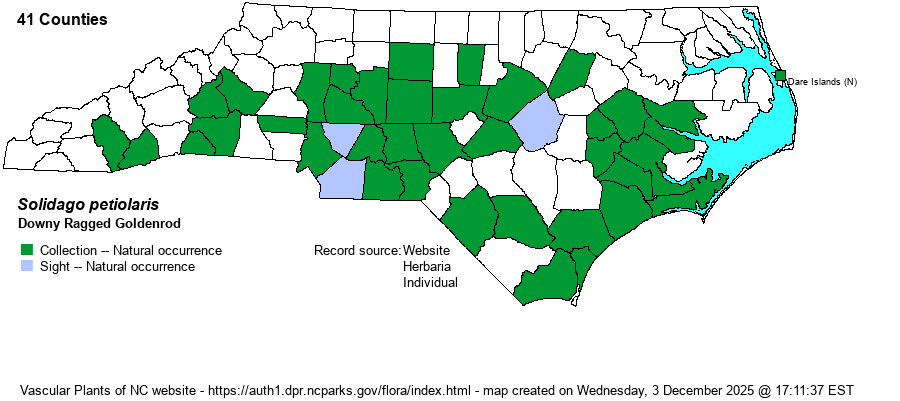| Author | Aiton | |
| Distribution | Piedmont and Coastal Plain, sparse in the southern Mountains; disjunct to the Outer Banks (Nags Head Woods). Absent from the Sandhills proper, and apparently absent from most Mountain counties. Not found in VA and the northern tier of NC counties.
NC to northern FL and MS. | |
| Abundance | Uncommon to locally fairly common in the southern and central Piedmont and Coastal Plain, north only to Dare, Nash, Guilford, and Burke counties. Sporadic in occurrence and absent from much suitable habitat. Rare in the southern Mountains. Surprisingly absent (seemingly) from the Sandhills.
| |
| Habitat | Dry to mesic woodland openings and ridges, upland forest edges, open wooded slopes, outcrops. It prefers light shade and is not a species of old fields and powerline clearings, as are some other goldenrods. It also seldom occurs in sandy soil, and the factors for it being localized are not clear. | |
| Phenology | Flowering and fruiting late August-October. | |
| Identification | This stately goldenrod grows 3-8 feet tall and has very short-hairy (puberulent) stems and leaf undersides. Leaves are numerous, elliptical, short pointed or blunt, and essentially without a stalk. These leaves tend to be similar in shape and size along the entire stem. It may be our only upland goldenrod that has numerous, elliptical leaves; its tall size -- often 4-6 feet tall -- can help in identification, as can its rather narrow (but not spike-like) inflorescence. | |
| Taxonomic Comments | Midwestern plants are by some treated as a separate species, or a variety. Many or most photos online seem to be of this Midwestern variety, as most plants in NC have widely elliptical and entire leaves with slightly rounded tips.
| |
| Other Common Name(s) | Downy Goldenrod | |
| State Rank | S4? [S4] | |
| Global Rank | G5 | |
| State Status | | |
| US Status | | |
| USACE-agcp | | |
| USACE-emp | | |

